
In the botanical classification of plants, Aeridinae Pfitzer is a subtribe of the tribe Vandeae whose representatives all have a monopodial growth habit and do not possess pseudobulbs.

Gypsophila is a genus of flowering plants in the carnation family, Caryophyllaceae. They are native to Eurasia, Africa, Australia, and the Pacific Islands. Turkey has a particularly high diversity of Gypsophila taxa, with about 35 endemic species. Some Gypsophila are introduced species in other regions.
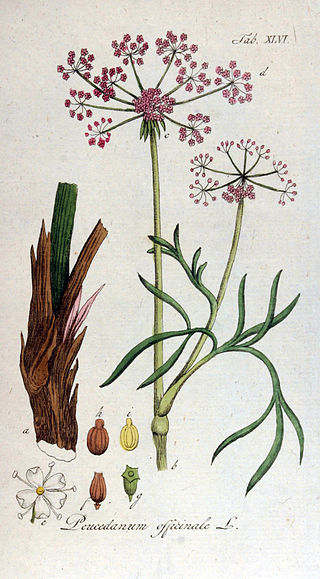
Peucedanum is a genus of flowering plant in the carrot family, Apiaceae. Peucedanum boasts a global presence with diverse spread of morphological features. Peucedanum species are characterized by dorsally compressed mericarps, slightly prominent dorsal ribs, narrowly winged lateral ribs, and a broad commissure. However, the vast diversity of morphology, fruit forms, and phytochemical production makes classifying species in the Peucedanum challenging. Historically relevant in traditional medicine, Peucedanum's taxonomic complexity arises from its extensive diversity.
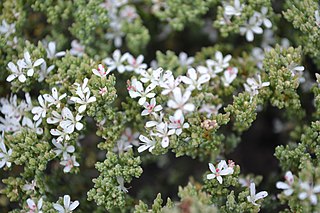
Frankenia is the only genus in the Frankeniaceae family of flowering plants. Other genera have been recognized within the family, such as Anthobryum, Hypericopsis and Niederleinia, but molecular phylogenetic studies have consistently shown that they all belong inside Frankenia. Frankenia comprises about 70–80 species of shrubs, subshrubs and herbaceous plants, adapted to saline and dry environments throughout temperate and subtropical regions. A few species are in cultivation as ornamental plants.
Acanthophyllum takhtajanii, or Takhtadjyan's allochrusa, is a species of flowering plant in the family Caryophyllaceae. It is endemic to Armenia, where it is only found in one location near Surenavan in the Urts Mountains in steppe at 800 m elevation. It is threatened by shifting agriculture and overgrazing.

Acanthophyllum is a genus of flowering plants in the family Caryophyllaceae with about 75 species, spread in the Irano-Turanian area.

Petrorhagia saxifraga, known as tunic flower or coat flower, is a small, herbaceous flowering plant in the family Caryophyllaceae. It is native to parts of Europe and introduced to the United States and Canada, Great Britain, and Sweden. Petrorhagia saxifraga is also known as tunic saxifrage, pink saxifrage, or just pink.
Telephium are a genus of flowering plants in the family Molluginaceae or Caryophyllaceae, found in Mediterranean parts of Europe, Africa, the Arabian Peninsula, and western Asia. They are annual or perennial herbs, sometimes becoming woody at their bases. Together with Corrigiola they form the tribe Corrigioleae.
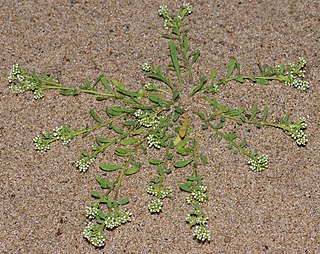
Corrigiola, the strapworts, are a genus of flowering plants in the family Caryophyllaceae, with a highly disjunct distribution in Mexico, South America, southern and eastern Africa, Madagascar, northwestern Africa, Europe and western Asia. Together with Telephium they form the tribe Corrigioleae.

Eremogone is a genus of flowering plants in the family Caryophyllaceae, native to western North America, northern Asia, eastern Europe and northeastern Africa. Attempts to resolve taxonomic relationships within the Caryophyllaceae have resulted in the enlargement of Eremogone with species from other genera.

Eudianthe is a small genus of flowering plants in the family Caryophyllaceae, found in the Canary Islands and the western Mediterranean. It can be distinguished from other members of the tribe Sileneae by its linear to narrowly lanceolate leaves and its pink flowers.
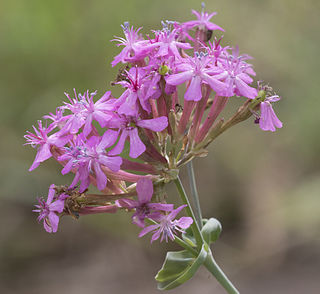
Atocion is a genus of flowering plants in the family Caryophyllaceae, tribe Sileneae, native to Europe, the Caucasus region, and the Middle East as far east as Iran. The species diversity is highest in the Balkans.
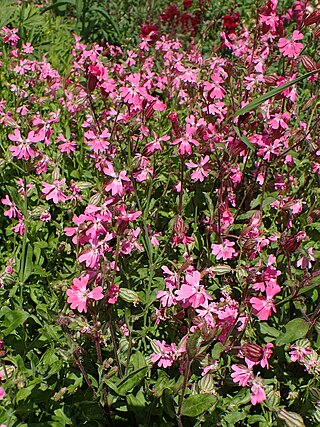
Silene pendula, called the nodding catchfly or drooping catchfly, is a species of flowering plant in the genus Silene, native to Italy, Greece, and Turkey, and introduced to scattered locations in North America, South America, Africa, Europe and Asia. A number of cultivars are available. A 2020 study showed with certainty that, despite their morphological similarities, Silene cisplatensis is not synonymous with Silene pendula.
Bolanthus is a genus of flowering plants belonging to the family Caryophyllaceae.
Cyathophylla is a genus of flowering plants belonging to the family Caryophyllaceae.

Mononeuria is a genus of flowering plants belonging to the family Caryophyllaceae.
Graecobolanthus is a genus of flowering plants belonging to the family Caryophyllaceae.
Phyllolobium is a genus of flowering plants belonging to the family Fabaceae.
Shivparvatia is a genus of flowering plants belonging to the family Caryophyllaceae.

Herbstia is a monotypic genus of flowering plants belonging to the family Amaranthaceae. It only contains one species, Herbstia brasiliana(Moq.) Sohmer It is within the Amaranthoideae subfamily.













